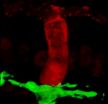(Press-News.org) Prison inmates frequently have a strong history of drug use and misuse, especially during the time prior to incarceration, and drugs often are the driving force behind the offense itself. New research, published in BioMed Central's newly launched open access journal Addiction Science & Clinical Practice, shows that ex-offenders struggle to remain drug free after release from prison and identifies factors that can help them succeed. Interviews with former inmates show that they themselves recognize that returning to former living environments (former friends and an easy access to drugs) is a strong trigger for drug use and overdose.
Researchers from the University of Colorado School of Medicine and Kaiser Permanente Colorado interviewed former prisoners within two months of their release from prison. The interviews focused on experience of drug and alcohol use after release from prison, perception of risk of overdose, and experience of overdose amongst other ex-inmates.
Four main points came clearly across from these interviews. Return to drug use was felt to be due to poor social support, or provided a way to cope with inadequate economic resources and health problems. Secondly, drugs were readily available in their living environment and a constant temptation. Studies based in the US have shown that there is a high risk of drug-related death after release from prison, and these ex-prisoners reported that while overdose was seen as a 'way out' in the face of overwhelming difficulties, accidental overdose, due to decreased drug tolerance, was also common. Finally, 'protective' factors including structured drug treatment programs, spirituality or religion, self-help groups, and family were identified as factors which strengthened them against relapse.
Dr Ingrid Binswanger, a Robert Wood Johnson Foundation Physician Faculty Scholar who led the study, summarized, "These interviews show that former inmates with a history of drug use, and criminal behavior related to their drug use, are often released back into environments with significant social and economic challenges, little support and readily available drugs. A consequence of this is a high risk of intentional and unintentional overdose. These people need structured treatment, a gradual transition back into the community, and coping strategies. They also need access to 'protective' factors, as well as improved resources, to reduce the main triggers for relapse."
In the words of one ex-prisoner, "...the hardest thing is not going back to the lifestyle that got me put in prison."
Addiction Science & Clinical Practice, relaunched today with BioMed Central, publishes research dedicated to improving the quality of care for people with unhealthy alcohol, tobacco, and other drug use, or addictive behaviors.
###
Notes to Editors
1. Return to drug use and overdose after release from prison: A qualitative study of risk and protective factors
Ingrid A Binswanger, Carolyn Nowels, Karen F Corsi, Jason Glanz, Jeremy Long, Robert E Booth and John F Steiner
Addiction Science & Clinical Practice (in press)
Please name the journal in any story you write. If you are writing for the web, please link to the article. All articles are available free of charge, according to BioMed Central's open access policy.
Article citation and URL available on request on the day of publication.
2. Addiction Science & Clinical Practice is an open access, peer-reviewed journal which provides a forum for clinically relevant research and perspectives that contribute to improving the quality of care for people with unhealthy alcohol, tobacco, or other drug use and addictive behaviors across a spectrum of clinical settings.
3. BioMed Central (http://www.biomedcentral.com/) is an STM (Science, Technology and Medicine) publisher which has pioneered the open access publishing model. All peer-reviewed research articles published by BioMed Central are made immediately and freely accessible online, and are licensed to allow redistribution and reuse. BioMed Central is part of Springer Science+Business Media, a leading global publisher in the STM sector.
4. The Robert Wood Johnson Foundation focuses on the pressing health and health care issues facing our country. As the nation's largest philanthropy devoted exclusively to health and health care, the Foundation works with a diverse group of organizations and individuals to identify solutions and achieve comprehensive, measurable, and timely change. For 40 years the Foundation has brought experience, commitment, and a rigorous, balanced approach to the problems that affect the health and health care of those it serves. When it comes to helping Americans lead healthier lives and get the care they need, the Foundation expects to make a difference in your lifetime. For more information, visit www.rwjf.org.
END
It can be difficult for someone outside of a specialist field to identify subject experts and the ever increasing amount of available data can be bewildering. New research, published in BioMed Central's open access journal, Journal of Biomedical Semantics, describes a method of social network analysis, similar to finding friends on Facebook, able to sift through scientific literature and news articles to identify opinion leaders and media experts.
Pharmaceutical companies and public health programs rely on opinion leaders to clarify and condense research into a format ...
New York, NY (March 14, 2012) — Columbia University Medical Center (CUMC) scientists have developed a way to recreate an individual's immune system in a mouse. The "personalized immune mouse" offers researchers an unprecedented tool for individualized analysis of abnormalities that contribute to type 1 diabetes and other autoimmune diseases, starting at the onset of disease. The findings were published today in the online edition of Science Translational Medicine.
The mouse model could also have clinical applications, such as predicting how a particular patient might ...
CLEVELAND -- A catheter procedure that closes a hole in patients' hearts was no more effective than medical therapy in preventing recurrent strokes, according to a new study published in the March 15 issue of the New England Journal of Medicine.
In the CLOSURE I trial, clinical researchers compared a catheter procedure plus medical therapy with medications alone to prevent new strokes or transient ischemic attacks (TIAs) in patients between 18 and 60 years old with an unexplained ("cryptogenic") stroke or TIA and a patent foremen ovale (PFO) – a hole between the heart's ...
VIDEO:
Using two-photon imaging, the researchers were able to see dendritic cells, shown in green, in the intestine of a living mouse.
Click here for more information.
With every meal, immune cells in the intestine stand like sentries at a citadel, turning away harmful bacteria but allowing vitamins and nutrients to pass.
Now, researchers at Washington University School of Medicine in St. Louis have identified the cells that chaperone food antigens, or proteins, in the ...
Of the $25 billion federal settlement funds for mortgage foreclosure abuses, Wisconsin will receive $140 million. The settlement money is being paid by J.P. Morgan Chase, Bank of America, Wells Fargo & Co, Citigroup and Ally (formerly GMAC), and is intended to help homeowners having difficulty making their mortgage payments and individuals who were the victims of improper foreclosures.
According to Assistant Attorney General Holly Pomraning in a recent TheNorthwestern.com article, Wisconsin's share of the settlement will be divided and distributed as follows:
- ...
Foodborne disease outbreaks caused by imported food appeared to rise in 2009 and 2010, and nearly half of the outbreaks implicated foods imported from areas which previously had not been associated with outbreaks, according to research from the Centers for Disease Control and Prevention, presented today at the International Conference on Emerging Infectious Diseases in Atlanta.
"It's too early to say if the recent numbers represent a trend, but CDC officials are analyzing information from 2011 and will continue to monitor for these outbreaks in the future," said Hannah ...
A team of researchers led by scientists at The Rockefeller University has identified a novel mechanism by which influenza interferes with antiviral host response. The finding, reported in this week's issue of the journal Nature, shows that the immunosuppressive NS1 protein of the influenza A virus hijacks key regulators of antiviral gene function by mimicking a core component of gene regulating machinery. The results they describe have major implications for our understanding of the biology of seasonal influenza virus and its pathogenesis. This research also suggests a ...
There was a lot of excitement a few years ago following the discovery of the DNA origami technique. The approach could be used to build nanoparticles of a given shape and size. However, real applications, such as nano-tweezers, remained out of reach. An international team of researchers led by Professor Tim Liedl of the Ludwig-Maximillians-Universitaet Muenchen and Professor Friedrich Simmel of the Technische Universitaet Muenchen have now succeeded in building nanoparticles using optically active DNA building blocks that can be used to modify light in very specific ways.
Coupling ...
STANFORD, Calif. -- A week ago, you started a new prescription medication for acne. Today, you feel dizzy and short of breath and have difficulty concentrating. Your symptoms are not listed in the package insert as possible side effects of the drug, but why else would you be feeling so odd?
Unfortunately, there's no easy answer. Clinical trials are designed to show that a drug is safe and effective. But even the largest trials can't identify irksome or even dangerous side effects experienced by only a tiny proportion of those people taking the drug. They also aren't designed ...
Menlo Park, Calif. — Researchers from Stanford University and the U.S. Department of Energy's SLAC National Accelerator Laboratory have created the first-ever system of "designer electrons" – exotic variants of ordinary electrons with tunable properties that may ultimately lead to new types of materials and devices.
"The behavior of electrons in materials is at the heart of essentially all of today's technologies," said Hari Manoharan, associate professor of physics at Stanford and a member of SLAC's Stanford Institute for Materials and Energy Sciences, who led the research. ...


